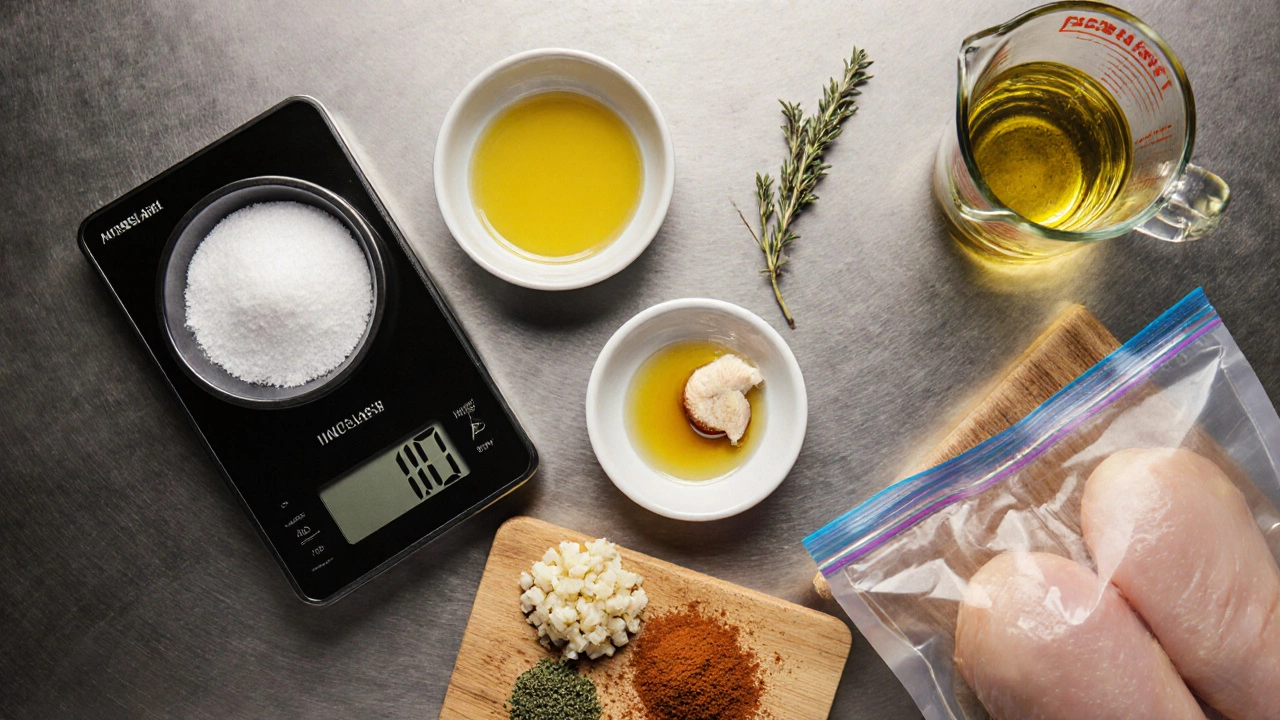Chicken Marinade Calculator
Calculate ingredients for a basic chicken marinade using the proven 1:2:1 ratio of salt:acid:oil. Input your chicken weight and select a flavor profile for customized measurements.
Use 0.5 kg (1 lb) for one serving, 1 kg (2.2 lb) for a family portion
Enter chicken weight and flavor profile to see calculations
Quick Takeaways
- Use a 1:2:1 ratio of salt:acid:oil for most chicken cuts.
- Add a touch of sugar or honey to balance acidity.
- Marinate at least 30minutes; up to 24hours for deeper flavor.
- Keep the mixture refrigerated to stay safe.
- Simple tweaks (herbs, garlic, soy sauce) let you switch cuisines in seconds.
If you’re after a basic chicken marinade that works every time, this formula has you covered.
Basic Chicken Marinade is a simple blend of salt, acid, fat, and flavorings that infuses chicken with moisture and taste. It follows the classic “four‑pillars” rule that chefs have used for centuries: salt+acid+fat+flavor. When you understand why each pillar matters, you can scale the recipe up or down, swap ingredients, and still end up with juicy, flavorful bird.
Understanding the Four Pillars
Salt draws water out of the meat, then allows it to be re‑absorbed along with any dissolved flavors. This process, called brining, helps the fibers relax and hold onto moisture during cooking.
Acid breaks down protein structures, tenderizing the meat and adding bright flavor can be citrus juice, vinegar, yogurt, or even wine. Too much acid kills the texture, so balance is key.
Oil coats the proteins, slows moisture loss, and carries fat‑soluble aromatics such as herbs and spices onto the surface.
Flavorings include herbs, spices, sweeteners, and aromatics that give the final taste its personality. Garlic, thyme, cumin, honey, or soy sauce each creates a distinct direction.

Core Ratio Explained
The simplest starting point is a 1:2:1 weight ratio for salt, acid, and oil. For a typical 1kg (2.2lb) of chicken, that works out to:
| Ingredient | Weight (grams) | Typical Volume |
|---|---|---|
| Salt | 10g | 1½tsp |
| Acid (lemon juice or vinegar) | 20g | 1½tbsp |
| Oil (olive or neutral) | 10g | 1tsp |
| Sweetener (honey or sugar) | 5g | ½tsp |
| Garlic, minced | 5g | 1tsp |
| Herbs/spices (e.g., thyme, paprika) | 5g | ½tsp |
These numbers are flexible. If you like more tang, add a little extra acid; if you prefer a richer mouthfeel, increase oil by the same amount as the added acid.
Step‑by‑Step Preparation
- Gather your ingredients. Measure by weight when possible - it’s the most reliable way to keep the ratio.
- In a bowl, dissolve the salt in the acid. Chicken benefits from this salted acidic solution because it begins the brining process right away.
- Add oil, sweetener, minced garlic, and your chosen herbs/spices. Stir until the mixture looks uniform.
- Place the chicken pieces (breasts, thighs, drumsticks, or a whole bird) in a resealable zip‑lock bag or shallow container.
- Pour the marinade over the chicken, seal, and massage gently so every surface is coated.
- Refrigerate. Minimum 30minutes for small pieces; 4-12hours for larger cuts; up to 24hours for a whole chicken.
- Tip: Rotate the bag halfway through the resting period for even coverage.
- When you’re ready to cook, remove the chicken, pat lightly to remove excess liquid (this helps achieve a crisp skin), and proceed with grilling, baking, or pan‑searing.
Flavor Variations Without Breaking the Formula
Because the ratio stays the same, you can switch the flavor base in seconds.
- Asian twist: Replace lemon juice with rice‑vinegar, swap olive oil for sesame oil, add 1tbsp soy sauce, and sprinkle five‑spice powder.
- Mexican vibe: Use lime juice, olive oil, add cumin, smoked paprika, and a dash of chipotle in adobo.
- Herb‑garden fresh: Double the thyme, add chopped rosemary, and finish with a splash of white wine.
Each variation respects the 1:2:1 balance, so you won’t end up with a soggy or overly sour result.

Common Mistakes and How to Dodge Them
- Over‑salting: Using table salt instead of kosher can add too much sodium because the crystals are finer. Measure by weight, not by volume.
- Skipping the chill: Leaving the bowl at room temperature lets bacteria grow. Always marinate in the fridge.
- Too much acid: A 1:2:1 ratio caps acid at twice the salt weight. Going beyond makes the meat mushy.
- Neglecting the oil: Without fat, the surface won’t brown well, and flavors won’t stick during cooking.
- Reusing the same marinade: Once it contacts raw chicken, it’s unsafe to reuse unless you boil it for at least 5minutes.
Storing the Marinade for Future Use
If you make a batch larger than needed, pour the unused portion into a clean jar, seal, and freeze. Frozen marinade stays good for three months. Thaw in the fridge before re‑using - never at the counter.
When you’re ready to marinate again, just add fresh salt and acid proportionally to compensate for any dilution from ice crystals.
Frequently Asked Questions
Can I use this formula for turkey or pork?
Yes. The same 1:2:1 ratio works for most poultry and lean pork cuts. Adjust cooking times accordingly.
Do I have to measure by weight?
Weight gives the most consistent results, especially when scaling the recipe. If you don’t have a scale, use the volume guide in the table and keep the proportions close.
Is it okay to marinate chicken overnight?
Absolutely. An overnight soak (12‑18hours) deepens flavor without compromising texture, as long as you keep it cold.
What if I don’t have lemon juice?
Replace it with an equal amount of apple cider vinegar, white wine vinegar, or even plain yogurt for a milder tang.
Can I add salt separately from the acid?
Yes. Some chefs sprinkle salt directly on the chicken first, then drizzle the acid‑oil mixture. The end result is the same as long as the total salt amount matches the ratio.
